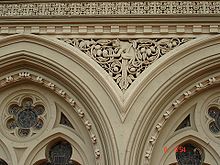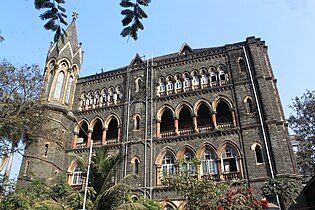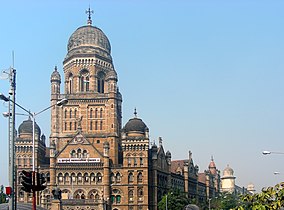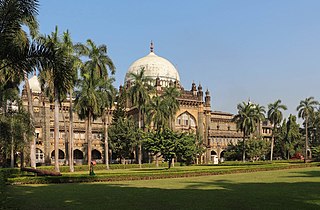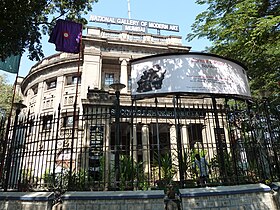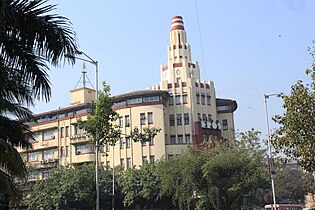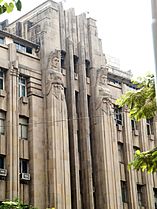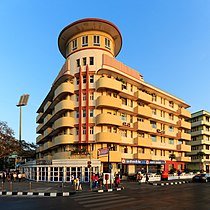Victorian Gothic and Art Deco ensembles in Mumbai
| Victorian Gothic and Art Deco ensembles in Mumbai | |
|---|---|
|
UNESCO world heritage |
|

|
|
| Main building of the Bombay High Court |
|
| National territory: |
|
| Type: | Culture |
| Criteria : | ii, iv |
| Surface: | 66.34 ha ha |
| Buffer zone: | 378.78 ha ha |
| Reference No .: | 1480 |
| UNESCO region : | Asia and Pacific |
| History of enrollment | |
| Enrollment: | 2018 ( session 42 ) |
Under the name Victorian Gothic and Art Deco Ensembles in Mumbai , an ensemble of buildings in the Indian city of Mumbai ( Bombay until 1996 ) was added to the UNESCO World Heritage List in 2018 . All buildings date from the British Indian era between the second half of the 19th century and the first half of the 20th century.
background
From 1661 Bombay was in English, later British possession and from 1668 in the possession of the British East India Company . The company expanded the initially small settlement into an administrative and commercial center and Bombay became the capital of the Bombay Presidency , which at the time of its greatest expansion from the 19th century encompassed large parts of today's coast of India and Pakistan to the Arabian Sea . After the British consolidated their power in India, defeated rival Indian princes and knocked out rival European colonial powers (France in particular), Bombay transformed in the 19th century from a fortified trading center into one of the largest cities in India and the “gateway to India World ”( Gateway of India ) and not only in terms of trade, but also in many cases in terms of culture. After the Indian uprising of 1857 , the East India Company's possessions were converted into a crown colony and this was elevated to an empire . In the subsequent phase of high imperialism, there was a strong desire for representative buildings that would symbolically represent British rule in India. Two governors in particular shaped the urban development of Bombay: John Elphinstone ( governor 1853–1860) and Henry Bartle Frere (governor 1862–1867). In the 1850s and 1860s, the old fortifications were razed and the previous glacis of the fortifications became available as building land. In addition, systematic land reclamation began in the 1860s and a development plan was implemented on the land that had become free.
A second urban expansion in downtown Bombay took place in the early 20th century, when large areas of land were extracted from the sea in the years 1928–1942 as part of the Backbay Reclamation Scheme . By the end of 1929 this was 552 acres (223 ha ). At the same time, the Art Deco architectural style found its way into Bombay. Initially, the areas west of the Oval Maidan and Churchgate were built in this style, and from the 1940s the coastal area of Marine Drive was also built . The architectural change also reflected the social change in Bombay, which was associated with the emergence of a western educated middle class, the new concept of separating living and working and living in apartment buildings. After India's independence in 1947 the Art Deco style in India came to an end largely because the new prime minister Jawaharlal Nehru to modernism preferred as modern architecture in India.
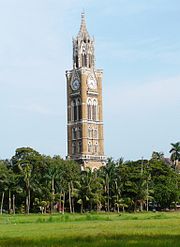
description
The area declared a World Heritage Site is in the south of Mumbai and covers 66.34 ha with a surrounding buffer zone of 378.78 ha. It consists of a group of 94 historical buildings and the open green area of the Oval Maidan . The buildings are partly in the Victorian style of the 19th century and partly in the Art Deco style of the first half of the 20th century. Some buildings, which were built around the turn of the century, show the "Indo-Saracen style" and others, mostly from the beginning of the century, are assigned to the so-called Edwardian style .
The Victorian or Anglo-Indian style corresponds essentially to an English neo-Gothic style , with architectural elements such as spiers , Tour Ellen , pointed arches , three-Fit , Four fit , gargoyles and vaults . Traditional Indian elements have been incorporated into this Gothic style, including roofs with terracotta tiles , openwork balconies, figure reliefs with men with turbans and in Indian costumes, verandas, etc. The building materials and the construction workers were from India. Basalt , which was extracted on the Deccan , served as the building material , while limestone from Porbandar in Gujarat was used for the decorative elements and facades . The building complexes of the University of Mumbai , the Bombay High Court , the Municipial Corporation Building and the Chhatrapati Shivaji Terminus (formerly Victoria Terminus , World Heritage since 2004) were built in this architectural style.
The Art Deco buildings were built in the 1930s and 1940s, on uncharted territory gained under the Backbay Reclamation Scheme of the 1920s. At the time, it was the first Art Deco style building in India. Reinforced concrete was used as building material, some of which was combined with traditional building materials such as bricks and paving stones. Here, too, Indian elements made of wood, marble and tiles were used, resulting in an overall style that was called "Indo-déco". The Art Deco buildings in Mumbai are considered the "largest coherent collection of Art Deco buildings east of Suez ".
The Indo-Saracen style was a style that was popular around the turn of the century and at the same time an attempt to create an "all-Indian" style. Indian architectural elements (mostly those from the Mughal period ) such as domes, chhatris , consoles , minarets , jalis and jharokhas were used. A prominent example of this architectural style is the former Majestic Hotel .
The Edwardian style (after Edward VII , reigned 1901-1910) was a kind of neo-renaissance that used classic facades with appropriate style elements (ornamental gables , Corinthian columns , high pilasters , classic motifs above the windows). Few buildings were built in this style, including today's National Gallery of Modern Art .
Inclusion in the world heritage
The application for inclusion in the World Heritage was submitted by the Indian government on January 29, 2014. At the 42nd meeting of the World Heritage Committee in Manama ( Bahrain ) from June 24 to July 4, 2018, the ensembles were included in the UNESCO World Heritage List.
Chhatrapati Shivaji Maharaj Vastu Sangrahalaya (formerly Prince of Wales Museum , Indo-Saracen style)
Web links
Individual evidence
- ↑ a b c d e f g h The Victorian and Art Deco Ensemble of Mumbai (India) No 1480. UNESCO website, 2019, accessed on July 9, 2019 (English).
- ↑ a b c Supplementary Information. (pdf) UNESCO website, accessed on July 13, 2019 .
Coordinates: 18 ° 55 ′ 53 " N , 72 ° 49 ′ 49.1" E

